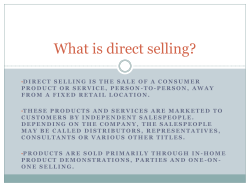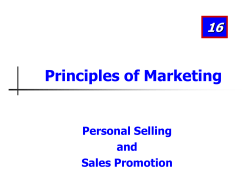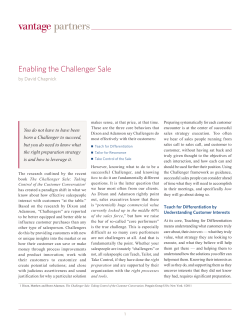
How to Map A Sales Process and Salespeople!) Will Follow
How to Map A Sales Process That Your Customers (and Salespeople!) Will Follow Sales Process Improvement Series Volume 3, Version 2.1 by Michael J. Webb President Sales Performance Consultants, Inc. © 2004 by Michael J. Webb All rights reserved. If you did not receive this file directly from Sales Performance Consultants, Inc., it is an illegal copy! Dedication To Leslie, who’s unwavering support and commitment has always enabled me to pursue my quest. Volume 3, Version 2.1 How to Map a Sales Process that Your Customers (and Salespeople) Will Follow Contents INTRODUCTION TO VOLUME 3, V2.1 ....................................................................... 1 PURPOSE AND STRUCTURE OF THIS BOOK .................................................................... 2 WHO SHOULD READ THIS BOOK .................................................................................... 3 MAJOR BENEFITS OF SALES PROCESS MAPPING .......................................................... 4 OVERVIEW OF SALES PROCESS MAPPING ......................................................... 6 TYPICAL PROBLEMS AND “SOLUTIONS” IN SALES ORGANIZATIONS .............................. 7 REASONS TO MAP THE SALES PROCESS ..................................................................... 10 KEY CONCEPTS BEHIND SALES PROCESS MAPPING ................................................... 12 TWO CASES IN POINT ................................................................................................... 16 THE FUNDAMENTAL “FIX”.............................................................................................. 18 PREPARING FOR SALES PROCESS MAPPING INITIATIVE............................. 20 GOALS OF A PROCESS MAPPING SESSION .................................................................. 20 IS YOUR ORGANIZATION READY? ................................................................................ 21 SET THE RIGHT EXPECTATIONS ................................................................................... 23 PREPARING TO LEAD THE PROCESS MAPPING SESSION............................................. 25 MORE POINTERS FOR FACILITATING THE PROCESS MAPPING SESSION .................... 28 CONDUCTING THE SALES PROCESS MAPPING SESSION............................. 31 ENSURE THAT EVERYONE UNDERSTANDS THE PROCESS APPROACH .......................... 34 STEP 1: IDENTIFY AND GROUP ACTIVITIES .................................................................... 40 STEP 2: CREATE A BASIC PROCESS MAP ........................................................................ 44 STEP 3: REFINE THE PROCESS MAP .............................................................................. 55 STEP 4: INTEGRATE THE PROCESS INTO THE ORGANIZATION ......................................... 57 STEP 5: IMPLEMENT THE PROCESS ............................................................................... 59 SALES PROCESS MEASUREMENT, REVISITED ............................................................. 60 CHARACTERISTICS OF STRONG AND WEAK PROCESS MAPS ...................................... 63 APPENDIX I EXAMPLES OF SALES PROCESS MAPS ...................................... 65 APPENDIX II AVOIDING THE FOUR MOST COMMON........................................ 77 APPENDIX III PROCESS MAPPING PRESENTATION TEMPLATES ............... 88 APPENDIX IV FOR MORE INFORMATION ............................................................. 89 Introduction to Volume 3, V2.0 This is the third of three volumes in the Sales Process Improvement Series, which apply principles and practices of quality improvement to sales and marketing. This volume— How to Map a Sales Process that Your Customers—and Salespeople—Will Follow— shows you how to do exactly that. It shows you how to develop a sales process that creates value for customers as well as for your company. When a sales process creates value for customers, your customers will follow it. When your customers follow the sales process, so will your salespeople. Sales processes are rarely designed to create value for customers. Usually, they aim to create value for the company doing the selling. That’s the major reason that customers don’t follow the sales process. It’s also why salespeople ultimately don’t follow it. Instead, they figure out for themselves how to work around the sales process in order to make their numbers and make a living. This workbook explains what I mean by the term “sales process” and provides ways of creating value for customers at every step of the process. The key tool in all of this, as the title of this book indicates, is Sales Process Mapping. In this book I will first discuss process mapping in general and then show how to map the sales process. (Incidentally, I generally use the term “sales process” in this volume to include marketing, sales, and service, not just the sales department.) Process mapping is a visual way of identifying the activities and tasks in a business or work process. Process mapping defines what gets done in a process, who does what, and what is produced at each stage. A process map resembles a flow chart and, like a flow chart, it can be drawn from a “35,000-foot altitude” to show only the major parts of a process, or from a more detailed, “lower altitude” perspective. In sales, the 35,000-foot altitude might cover activities such as Qualify Prospect, Conduct Sales Call, Submit Proposal, Close, and Set Up Account. Or the process map can zoom Volume 3: Sales Process Mapping Page 1 of 90 in on a single part of the process. For instance, for Set Up Account, it could show Create New File, Assign Account Number, Establish Billing Cycle, and so on. There are different kinds of process maps for different types of processes, which you needn’t worry about. For instance, I won’t burden you with ways of documenting technological processes, such as defining software system requirements. Instead, I’ll give you just what you need to map your sales process. Our goal here is to identify, coordinate, measure, and improve your marketing and selling activities. Specifically, we will use Sales Process Mapping to: • Identify the best ways to create value for your customers and your organization • Clarify working relationships between marketing, sales, and customer service • Establish goals, priorities, and metrics to enhance the performance of sales and marketing people • Make the most of support functions, such as training and development, performance evaluation, and CRM software • Establish a common language for focusing on the customer. In mapping your sales process, people in your marketing, sales, and service areas will learn how what they do fits together and how it contributes to the organization. I have found that this generates teamwork and energy in ways that pep talks and even financial incentives cannot. Purpose and Structure of this Book The purpose of this book is to help marketing, sales, and general managers boost the performance of marketing and sales. The last thing I want you to think is that sales process mapping is an end in itself. It is a tool that will give you a better grasp of your marketing and sales process than any other single initiative you could undertake. But it Volume 3: Sales Process Mapping Page 2 of 90 does more than just improve your understanding. It also shows how to improve the results generated by specific activities in the marketing and sales process and establishes ongoing efforts to improve the overall process. Here’s how I’ve structured this book: Part 1 introduces you to process mapping in general and to sales process mapping in particular. I explain these techniques, discuss reasons to map the sales process, and show why and how it improves sales results. In Part 2, you will learn how to judge your organization’s readiness for a sales process mapping initiative, how to prepare for such an initiative. Part 3 shows you how to conduct a sales process mapping session and includes a scripted presentation (complete with exhibits) for you to use in facilitating the session. Appendix I provides examples of Sales Process Maps for organizations in various industries. Appendix II discusses the four most common mistakes in sales process mapping and how to avoid them. Appendix III provides a template for a sales process map and for process mapping session exhibits. At the end of the book you will also find resources for more information and a note on the author. Who Should Read This Book This workbook is intended for people who want to lead a sales process mapping initiative in their sales organization. The book will guide you through the process of planning and conducting a five-step sales process mapping workshop. This is not a book for one person to use in isolation. Sales process mapping constitutes a team effort, and that effort requires leaders. Thus this book is for: Volume 3: Sales Process Mapping Page 3 of 90 • Marketing and sales managers who want to improve the operation and results of their departments • General managers with responsibility for their organization’s sales and marketing function • Marketing and sales people who are preparing for management roles and who want to understand sales as a process • Quality and process improvement professionals who want to lead or support a Sales Process Improvement or process mapping effort in their organization • Management, sales, and marketing consultants and sales trainers, who want a deeper understanding of the sales process and who want to help their clients develop such an understanding A sales process mapping session enables you, in a structured way, to set up an effective sales process. An effective sales process demands collaboration across departments. The interconnectedness of process mapping helps people achieve that collaboration in a very logical, unforced way. Major Benefits of Sales Process Mapping If you implement the recommendations in this workbook, you and your group will: • Learn “who’s doing what” in your marketing, sales, and service functions and how those activities mesh, or fail to mesh • Create a map that shows how each step of your sales process can deliver value to your customers • Identify and prioritize metrics that accurately portray the performance of sales and marketing activities • Develop the consensus needed for serious efforts to improve your marketing and sales activities—and their results—permanently Volume 3: Sales Process Mapping Page 4 of 90 First, however, a few words of caution regarding things that this workbook does and does not do. This workbook does: This workbook does not: • Enable you to develop an organizational process map, an essential component in an overall Sales Process Improvement initiative • Provide everything you need to launch a change management, CRM, or global re-engineering initiative. • • Help you identify your business’s value from your customer’s perspective Deal with mapping detailed systems requirements (e.g., for software systems) or operating procedures. • Help you align marketing and sales efforts with those of quality or IT people • • Assume basic familiarity with flowcharting. Cover technical issues, such SADT and other mapping methodologies. (SADT, or Structured Analysis and Design Technique, is a graphical approach to describing a system.) • Provide detailed instruction on flowcharting techniques. Thus this book is for hands-on use by people who will work directly with sales and marketing people to map and improve the sales process. The resulting map will identify each activity in the sales process, and its relationship with other activities, as well as the results it produces. That’s essential knowledge if you are going to improve your sales process. In other words, without a sales process map, you won’t know the territory and will probably wind up lost. With such a map, you can chart a clear path to sales improvement. Volume 3: Sales Process Mapping Page 5 of 90 Part I Overview of Sales Process Mapping Sales Process Improvement assumes that sales is a process, and that you can improve a process by identifying its parts and individually improving each one. That’s also the assumption of process improvement: A work process comprises certain activities and each of those activities can be improved, which will improve the results that they, and the whole process, produce. Figure 1 shows a simple sales process map. Note that one of the key features is that the map shows how one activity feeds into the next. As you’ll see later, more complex maps detail each key activity, along with the results they produce. (A diamond-shaped box denotes a point where a decision must be made.) Draft Process Map Marketing Marketing Qualifying Qualifying Selling Selling Information Information System System Planning Planning Objectives Market/Comp Market/Comp Analysis Analysis Qualification Assess Leads Account Account Planning Planning Opportunities Prepare Prepare Proposal Proposal Vertical/Product Vertical/Product Focus Focus Research Research Present Present Proposal Proposal Collateral Collateral Gain Access Ask for the Order Publicity/ Publicity/ Promotions Promotions Relationship Relationship Presentation Presentation 2003 © Copyright Sales Performance Consultants, Inc. Figure 1: A Simple Sales Process Map Volume 3: Sales Process Mapping Page 6 of 90 Orders 27 A business process, such as a production process, takes inputs and by working on them, usually with machinery, converts them to outputs. Inputs are raw materials; outputs are products. The raw material of sales is people in the market for what you sell. More specifically, it is people who have the problems that your organization solves, or the opportunities that your organization helps them leverage. (This idea is covered in detail in How to Develop Qualification Criteria that Help You Find and Win Customers, which is Volume 2 in the Sales Improvement Series.) The sales process converts those people to customers. So, people in the market with certain problems or opportunities (i.e., prospects) are the “input” and customers are the “output” of the sales process. Every marketing, sales, and service activity plays a part in that conversion process. Each has a goal of getting the prospect take some incremental action or step. (of course this can only be done if the customer sees value in doing so.) The better each activity plays its part, the better the performance of the sales process. The better the performance of the sales process, the more—and more high quality—customers you will have. The logic of this is unassailable: You identify each activity, that is, each phase in the “work.” You identify and measure the input and output for each activity. Then you improve each activity to improve its output. As a result, the output of the entire system improves. Do you see what a departure this is from the usual “fixes” for sales problems? If not, the next section will clarify the situation. Typical Problems and “Solutions” in Sales Organizations Here’s a typical sales manager with a typical problem: A VP of Marketing and Sales for a small manufacturer of fluid-mixing equipment asked me if I knew where he might be able to get an aptitude test for salespeople. Volume 3: Sales Process Mapping Page 7 of 90 “I think we may be hiring the wrong kind of salespeople,” he said. “They can’t seem to find the kind of prospects we need to make our numbers. They’re finding deals for one or two machines, but we need deals for one or two hundred machines.” “What are they spending their time on?” I asked. “Well, our pricing is tricky. Only about 10% of our orders are for standard products, the other 90% seem to be one-offs. So they deal with endless miscommunications around invoices, and other customer service problems. Some customers say that we’re hard to do business with.” “Why would a large customer want to do business with you?” I asked. “What value can you create for them?” “I think we have a good value proposition. But it’s hard to focus on it when we have all this other stuff going on.” I wondered: How could salespeople be expected to sell to large accounts without a clear value proposition and the right organizational support? How could this company have credibility with those customers if it hadn’t addressed basic pricing and customer service issues? We’ve all heard similar stories. Not making the numbers? Not bringing in enough business? Can’t land large accounts? It must be the salespeople (or the sales manager). Let’s hire new ones. Let’s train them some more. Let’s change their incentives. Aren’t these “the usual fixes” for sales problems? Yet very often the problems are far more fundamental—and far beyond the salespeople’s control. In those situations, the usual “fixes” won’t work. Yet one of the usual fixes is often the first and only thing that management does. These “fixes” include: • Sales training • CRM software Volume 3: Sales Process Mapping Page 8 of 90 • Marketing promotions • New VP of sales • More spent time on forecasts • Changes to the compensation plan • Sales contests How do companies choose among these alternatives? Most executives go by gut feel because they have so few numbers to rely on. Compared to their counterparts in production, when it comes to information, most sales executives are flying blind. Why? Because sales has not been managed as a production process. Instead, it’s managed on one or more of the following assumptions: • Sales is an art, not a science. It depends on personalities and relationships, which can’t be measured. • Great salespeople are born, not made. We depend mainly on these extraordinary people to achieve our goals. • Sales is something we do to the customer. When we do it persistently and aggressively enough, we win. • Quota shortfalls result from salespeople’s failures. When they occur we must “manage” the salespeople differently. • Top-line revenue results are the goal in sales. We leave profitability to the manufacturing, service delivery, and costmanagement functions. • Marketing and sales are separate activities, so we deal with them separately. Beliefs like these, often held by senior executives, lay at the root of most sales problems. These beliefs preclude true analysis of the sales process and its shortcomings, gaps, and weak links. These beliefs blind managers to what might be helpful to salespeople and, by extension, to customers (or, for that matter, helpful to customers and, by extension, to salespeople). These beliefs ensure that people repeat their mistakes and that problems Volume 3: Sales Process Mapping Page 9 of 90 persist. Why? Because when you act on these beliefs, forgo true analysis, and implement one of the usual fixes, you cannot identify the causes and effects of what actually goes on in the sales process, nor can you identify actual fixes. Fortunately, there is now an alternative. Reasons to Map the Sales Process Over the last ten years, the scientific analysis and data-based decision making of the quality movement have seeped into sales and marketing. Sales and marketing people are, from their varying perspectives, seeing the need for these approaches. For example, attendees in my various workshops have mentioned that they want to: • Find, gain, and keep more of the right kind of customers—at less cost • Enhance their understanding of customers and improve satisfaction • Coordinate marketing, sales, and customer service more effectively • Prepare for a CRM (or sales automation) initiative • Improve planning, forecasting, and management control • Establish a continuous improvement program (such as Six Sigma) • Meet ISO, Malcom Baldridge, or similar requirements. These are all excellent reasons for a sales process mapping initiative. They all recognize that we in sales and marketing must employ scientific methods—rather than shopworn “fixes”—to improve results. Benefits of Sales Process Mapping Process mapping facilitates systematic analysis of a work process. It forces you to: 1. Be thorough and consistent in identifying activities and results 2. Ask questions that you haven’t asked before Volume 3: Sales Process Mapping Page 10 of 90 3. Engage people from all parts of the sales process in efforts to improve it Process mapping will uncover many opportunities for improvement in any business process that has not been carefully analyzed. In my experience, sales process mapping can generate significant business results by enabling an organization to do the following: Establish a True Sales Operating System • Establish metrics and systems for capturing valuable data related to finding, winning, and keeping customers • Define the skills and competencies required of salespeople, keyed to specific sales activities and supported by results from the field • Generate consensus on the sales department’s business requirements, as a basis for defining its functional requirements • Improve information flows and working relationships among marketing, sales, and customer service people Enhance Sales and Marketing Performance • Develop measures for activities related to individual market segments, product lines, and customers • Identify baseline performance measures of the sales process, such as output per headcount, factors affecting close ratios, and elapsed times for completion of activities (e.g., proposal generation, account set up) • Improve results significantly over the baseline performance measures • Identify the reasons for successful and unsuccessful deals with greater precision Improve the Interface with Customers • Improve ability to compare customer account relationships and performance and allocate resources more effectively Volume 3: Sales Process Mapping Page 11 of 90
© Copyright 2025





















